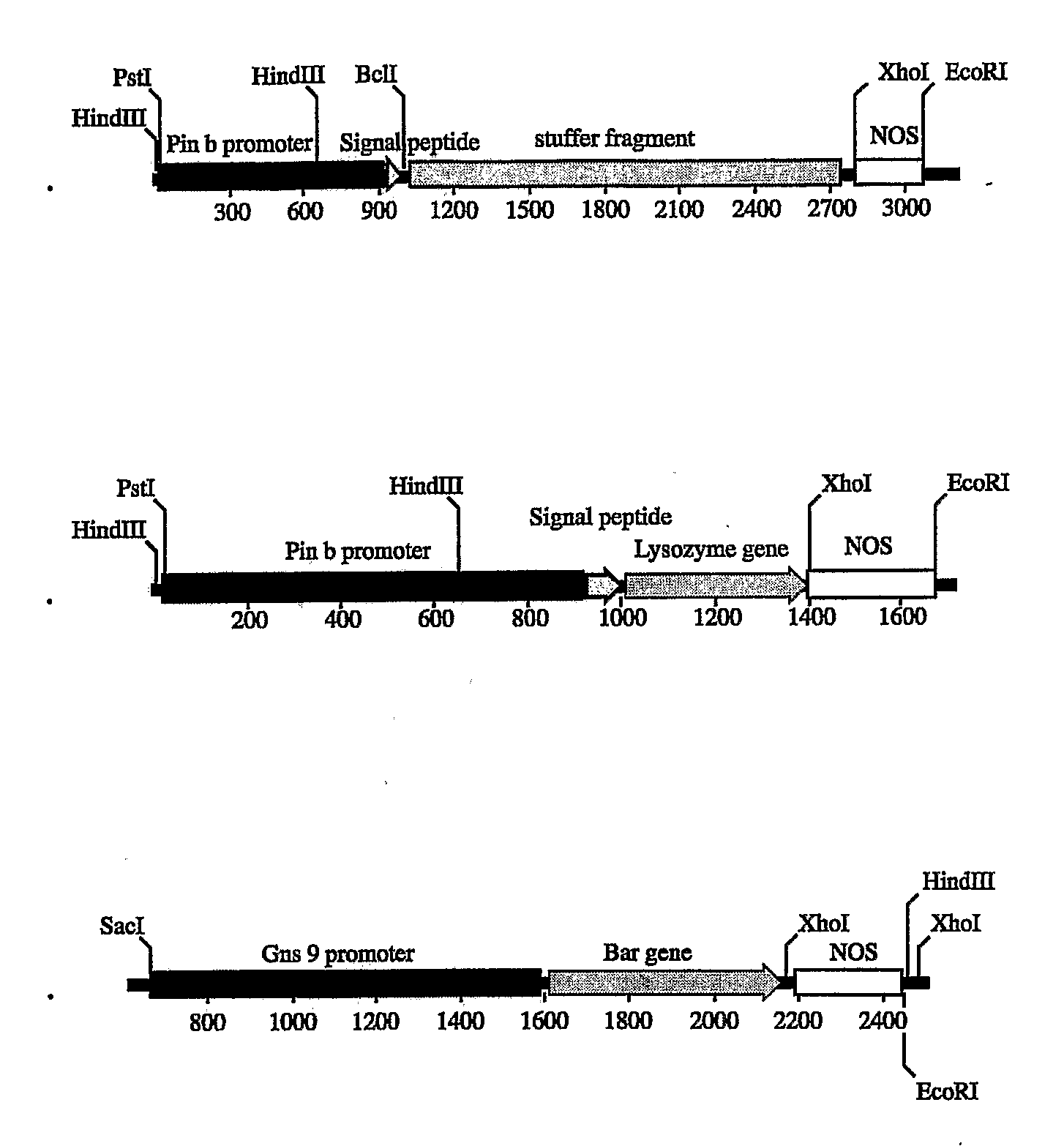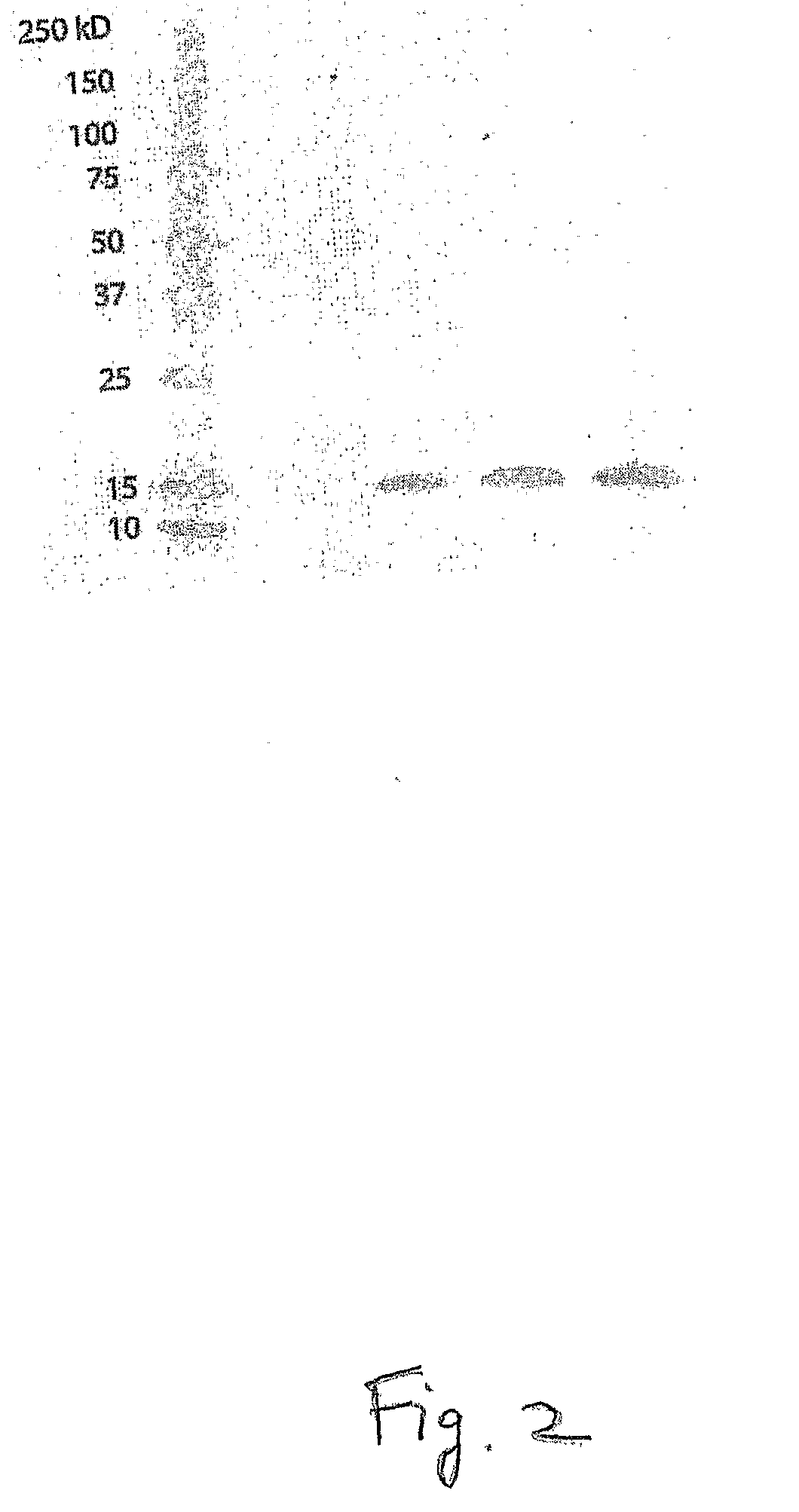Methods of Expressing Heterologous Protein in Plant Seeds Using Monocot Non Seed-Storage Protein Promoters
a technology of plant seeds and promoters, applied in the field of methods of expressing heterologous proteins in the seeds of angiosperm plants, can solve the problems of not concluding the storage location of albumin, many human proteins are in short supply, and none of these patents disclose the production of heterologous proteins
- Summary
- Abstract
- Description
- Claims
- Application Information
AI Technical Summary
Problems solved by technology
Method used
Image
Examples
example 1
Construction of Plasmids
[0088]A 1,061 bp fragment containing the wheat puroindoline b promoter and signal peptide was amplified from genomic DNA of Triticum aesvestium, cv. Bobwhite by Pfu DNA polymerase using reverse primer: 5′-GGGAATATTGTACCAGCCGCCAACTTCTGA-3′ and forward primer: 5′-CCGCTGCAGCTCCAACATCTTATCGCAACATCC-3′, designed from the sequences of Genbank accession number AJ000548. The reverse primer introduces a silent mutation into the signal peptide, creating a Bcl I site for in-frame fusion of a recombinant gene. The fragment was cloned into the pCR2.1 vector (Invitrogen, Carlsbad, Calif.). After confirmation by sequencing analysis, the fragment was cut by SphI, and cloned into the NaeI / SphI site of API241 (Hwang et al., “Analysis of the rice endosperm-specific globulin promoter in transformed rice cells”, (2002) Plant Cell Report 20: 842-847). This backbone contains a 1.8 kb stuffer fragment, the nopaline synthase terminator (NOS), and an ampicillin resistance selectable m...
example 2
Generation of Transgenic Rice Plants
[0090]A selectable marker construct pAPI146, consisting of the hygromycin B phosphotransferase (Hph) gene driven by the Gns9 promoter and followed by the NOS terminator (Huang et al., “The tissue-specific activity of a rice beta-glucanase promoter (Gns9) is used to select rice transformants”, (2001) Plant Sci. 61: 589-595)), was used as the selectable marker in all transformations except for the gene stacking experiment. For gene stacking, the calli derived from a transgenic line, 159-53, already carrying pAPI146, so a second selectable marker construct, pAPI291 carrying the Gns9 promoter, Bar, and NOS terminator was used for selection of transgenic calli. Microprojectile-mediated transformation of rice was carried out according to the procedure described in Yang et al. (“Expression of the REB transcriptional activator in rice grains improves the yield of recombinant proteins whose genes are controlled by a Reb-responsive promoter”, (2001) Proc Na...
example 3
Isolating the Heterologous Protein
[0093]Total protein extracts of seeds and other tissues were prepared by grinding the tissue under liquid nitrogen, then adding protein extraction buffer (66 mM Tris, pH 6.8, 2% SDS, 2% β-mercaptoethanol). Proteins were separated by 4-20% polyacrylamide gel electrophoresis (PAGE), and then transferred to nitrocellulose membranes according to the manufacturer's instructions (BioRad). Blots were blocked in blocking solution (PBS, pH 7.4+5% non-fat dried milk, 0.02% sodium azide, 0.05% Tween 20) at 4° C. overnight. Next, the blot was incubated with a 1:2500 dilution of anti-lysozyme antibody (CalBiochem, San Diego, Calif.) in blocking solution for 1 hour at room temperature. Blots were washed three times with PBS, and then incubated with a 1:4000 dilution of AP-conjugated rabbit anti-sheep IgG antibody (Sigma, St. Louis, Mo.) in blocking solution for 1 hour at room temperature. Finally, the blots were washed 3 times with TBS (pH 7.4) and developed with...
PUM
| Property | Measurement | Unit |
|---|---|---|
| Dimensionless property | aaaaa | aaaaa |
| Dimensionless property | aaaaa | aaaaa |
| Dimensionless property | aaaaa | aaaaa |
Abstract
Description
Claims
Application Information
 Login to View More
Login to View More - R&D
- Intellectual Property
- Life Sciences
- Materials
- Tech Scout
- Unparalleled Data Quality
- Higher Quality Content
- 60% Fewer Hallucinations
Browse by: Latest US Patents, China's latest patents, Technical Efficacy Thesaurus, Application Domain, Technology Topic, Popular Technical Reports.
© 2025 PatSnap. All rights reserved.Legal|Privacy policy|Modern Slavery Act Transparency Statement|Sitemap|About US| Contact US: help@patsnap.com



